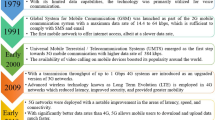Abstract
In this paper, we consider a topology control problem that dynamically configures the path and capacity for constructing a multi-hop backbone network under the varying traffic load in TDD–OFDMA system. In order to deal with the co-channel interference among the different relay stations, \(K\) orthogonal subframes of OFDMA data regions are spatially reused. We present a joint path and capacity design problem that maximizes the average effective delay per bit while properly trading off the outage performance. Due to the complexity of optimal solution approach to this problem, we resort to a genetic algorithm that finds the mobile multi-hop architecture by solving the dynamic topology design problem and compare its solution to the results from the existing heuristic algorithms.









Similar content being viewed by others
Notes
In [7], this is referred to as the effective delay per bit.
References
IEEE Std 802.16e. (2006). Part16: Air interface for fixed and mobile broadband wireless access systems, amendment 2: Physical and medium access control layers for combined fixed and mobile operation in licensed bands.
IEEE Std 802.16j. (2009). Part 16: Air interface for broadband wireless access systems, amendment 1: Multiple relay specification.
IEEE Std 802.16m. (2011). Part 16: Air interface for broadband wireless access systems, amendment 3: Advanced air interface.
3GPP TS 36.300. (2012), 3rd Generation Partnership Project, Evolved Universal Terrestrial Radio Access (E-UTRA) and Evolved Universal Terrestrial Radio Access Network (E-UTRAN); Overall description; Stage 2 (Release 10).
Tao, Z., Li, A., Teo, K. H., & Zhang, J. (2007). Frame structure design for IEEE 802.16j mobile multihop relay (MMR) networks. In IEEE global telecommunications conference (Globecom 2007) (pp. 4301–4306).
Ghosh, D., Gupta, A., & Mohapatra, P. (2007). Admission control and interference-aware scheduling in multi-hop WiMAX networks. In IEEE mobile ad hoc and sensor systems (MASS) (pp. 1–9).
Kang, H. J., Ryu, H. S., & Kang, C. G. (2009). Dynamic topology control for multi-hop relaying in a cellular TDD-OFDMA system. In Wireless communications and networking conference (IEEE WCNC 2009) (pp. 1314–1319).
Kim, Y., & Sichitiu, M. L. (2011). Optimal max–min fair resource allocation in multihop relay-enhanced WiMAX networks. IEEE Transactions on Vehicular Technology, 60(8), 3907–3918.
Ikki, S. S., & Aïssa, S. (2012). Multihop wireless relaying systems in the presence of cochannel interferences: Performance analysis and design optimization. IEEE Transactions on Vehicular Technology, 61(2), 566–573.
Saad, M. (2009). Optimal spectrum-efficient routing in multihop wireless networks. IEEE Transactions on Wireless Communications, 8(12), 5822–5826.
Gurewitz, O., de Baynast, D., & Knightly, E. W. (2007). Cooperative strategies and achievable rate for tree networks with optimal spatial reuse. IEEE Transaction on Information Theory, 53(10), 3596–3614.
Wu, T.-M., & Wang, S.-L. (2011). Routing selection with overloading cancellation for multihop cellular systems. IEEE Communications Letters, 15(1), 61–63.
Goldberg, D. (1989). Genetic algorithm in search, optimization, and machine learning. Reading, MA: Addison-Wesley.
Acknowledgments
This research was supported in part by IT R&D program of MKE/IITA [Research on Ubiquitous Mobility Management Methods for Higher Service Availability] and also was a part of the project titled ‘Research on fundamental core technology for ubiquitous shipping and logistics’ funded by the Ministry of Oceans and Fisheries, Korea.
Author information
Authors and Affiliations
Corresponding author
Rights and permissions
About this article
Cite this article
Kang, H.J., Kang, C.G. GAMMA: Genetic Algorithm for Link-Adaptive Joint Path and Capacity Design in Mobile Multi-Hop Relay System. Wireless Pers Commun 78, 579–597 (2014). https://doi.org/10.1007/s11277-014-1772-5
Published:
Issue Date:
DOI: https://doi.org/10.1007/s11277-014-1772-5




